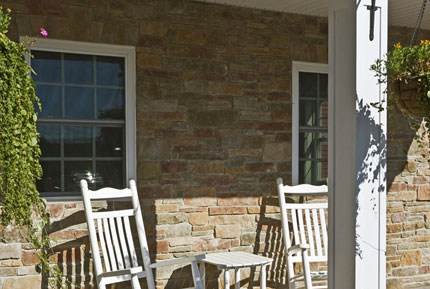Stone Veneer-Brick Veneer
Application of slate stone veneer
Interior surfaces
- Fireplaces
- Interior Walls
- Bathrooms
Exterior Surfaces
- Old Chimney can be given a facelift
- Cover Brick or Wood
- Dress up a concrete wall
Interior and Exterior Stone Veneer
For home owners, designers, contractors and architects alike, hearing about a hot new trend in interior and exterior design is always exciting.
But learning that a new trend is also cost-effective is really music to everyone’s ears in the current economic landscape. Exterior and Interior stone veneer fit that exact bill. They’re an attractive and increasingly popular way to decorate a home, but they’re more than that. Stone veneers are also an extremely cost-effective alternative that saves builders and buyers crucial dollars in a time when every penny counts.
What are stone veneers?
They achieve the same look, texture, color and shape as natural stone. The key difference. . . Stone veneers give homes all the benefits of real stone – but at a fraction of the price.
Stone veneers are comprised of Portland cement, some lightweight real stone elements, iron oxide pigments, water repellents and various polymers. If that sounds like wall stone jargon to you, the simpler way to understand stone veneers is that they’re comprised of various components that achieve the look of natural stone and are designed to withstand the elements.
The Benefits of Stone Veneers
Stone veneers replicate virtually any type of stone wall you can imagine, including ledge stone, castle stone, limestone and other types of wall stone. This popular new trend is also cost-effective both directly and indirectly. In the strictest sense, the thinner, lighter materials in stone veneers make the product less expensive than natural stone. Indirectly, because of their lightweight composition, stone veneers don’t take the same toll on a household that real wall stone does. They are light enough that they can be easily installed in virtually any interior stone or exterior stone application. Moreover, they don’t require expensive extensions or reinforcements to a house’s foundation. Because of their more convenient design, stone veneers are also significantly easier to transport than natural stone.
Indoor and outdoor uses
Stone veneer or Brick Veneer users, whether they’re building a home, selling one or buying one, are usually ahead of the curve in terms of home design trends. It’s thus no wonder that they’ve found so many different uses for stone veneers already.
For example, interior stone veneer& brick veneer is used in fireplaces, stairways, wine cellars, bars and, of courses, kitchen islands, a key piece of any “dream home.”
Exterior stone veneer can accentuate gardens, sculpting a natural look at an affordable price. They can also jazz up patios and grill areas, giving home owners the “place to be” around the neighborhood in the summertime.
Stone Veneer – Brick Veneer inspired by nature, designed by you
Whether you prefer the rugged look of a western lodge or the regal style of an Old World castle, there is a stone veneer or brick veneer designed for your next project. Concrete stone veneer is a cost-effective way to capture the beauty of stone inside or outside your home.
You choose what’s best for your project. A few things to keep in mind:
Cost – One of the most debated advantages to thin stone veneer is the overall cost savings that homeowners and contractors will reap in using it. So, first and foremost, it’s the fact that it is faster and you get your job done quicker.
Weight – Because it weighs less than natural stone, stone veneer & brick veneer are easier and faster to install and, in most cases – more economical to use than traditional, full-dimension stone veneer. The lighter weight of the thin stone means that homeowners and contractors alike, can haul and install it that much faster than the heavier, full-depth stone. Also, thin veneer can be essential for bringing stone to non-load bearing walls, as well as help architects and engineers in the overall design. One of the main advantages of the thin veneer is that, when weight is a problem, like veneering an entire two-story house, how that weight is distributed throughout the building and projects down the walls and into the footings is majorly important. That’s an engineer’s nightmare and they like thin veneer because of that.
Size – Obviously, another main advantage of thin stone veneer is how much — or really, how little — space it takes up. Traditional, full-dimension stone masonry can range anywhere from two inches and up depending on the structure and building needs. Therefore, thin stone’s slimmer profile, ranging from 3/4-inch to two-inches, can be a great alternative for projects with limited space or other special considerations.
Areas We Service
 Freehold, Manalapan,
Freehold, Manalapan,
Marlboro, Colts Neck,
Farmingdale, Howell, Jackson,
Millstone, Old, Bridge,
Jamesburg, Holmdel, Tinton Falls,
Jackson, Lakewood, East Brunswick,
Middletown, Red Bank, Eatontown,
Asbury Park, Brick,
Lakehurst, Allentown, East Windsor





